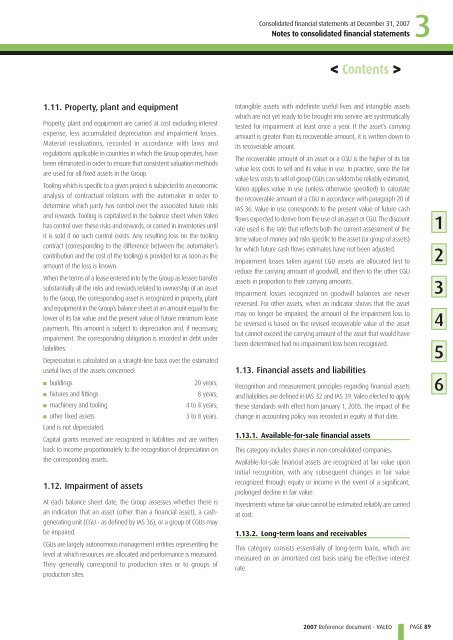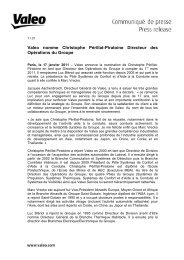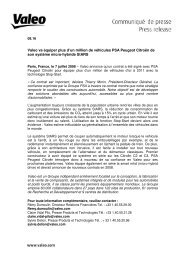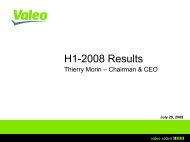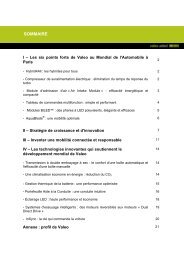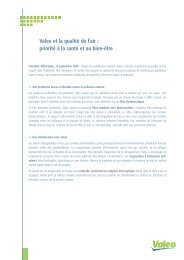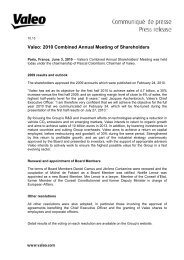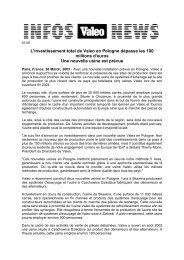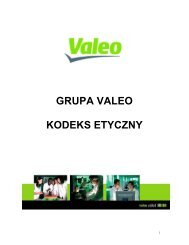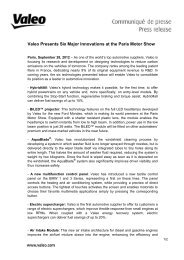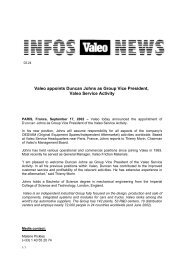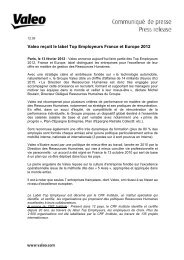2007 Reference document (PDF) - Valeo
2007 Reference document (PDF) - Valeo
2007 Reference document (PDF) - Valeo
You also want an ePaper? Increase the reach of your titles
YUMPU automatically turns print PDFs into web optimized ePapers that Google loves.
1.11. Property, plant and equipment<br />
Property, plant and equipment are carried at cost excluding interest<br />
expense, less accumulated depreciation and impairment losses.<br />
Material revaluations, recorded in accordance with laws and<br />
regulations applicable in countries in which the Group operates, have<br />
been eliminated in order to ensure that consistent valuation methods<br />
are used for all fixed assets in the Group.<br />
Tooling which is specific to a given project is subjected to an economic<br />
analysis of contractual relations with the automaker in order to<br />
determine which party has control over the associated future risks<br />
and rewards. Tooling is capitalized in the balance sheet when <strong>Valeo</strong><br />
has control over these risks and rewards, or carried in inventories until<br />
it is sold if no such control exists. Any resulting loss on the tooling<br />
contract (corresponding to the difference between the automaker’s<br />
contribution and the cost of the tooling) is provided for as soon as the<br />
amount of the loss is known.<br />
When the terms of a lease entered into by the Group as lessee transfer<br />
substantially all the risks and rewards related to ownership of an asset<br />
to the Group, the corresponding asset is recognized in property, plant<br />
and equipment in the Group’s balance sheet at an amount equal to the<br />
lower of its fair value and the present value of future minimum lease<br />
payments. This amount is subject to depreciation and, if necessary,<br />
impairment. The corresponding obligation is recorded in debt under<br />
liabilities.<br />
Depreciation is calculated on a straight-line basis over the estimated<br />
useful lives of the assets concerned:<br />
■ buildings 20 years;<br />
■ fixtures and fittings 8 years;<br />
■ machinery and tooling 4 to 8 years;<br />
■ other fixed assets<br />
Land is not depreciated.<br />
3 to 8 years.<br />
Capital grants received are recognized in liabilities and are written<br />
back to income proportionately to the recognition of depreciation on<br />
the corresponding assets.<br />
1.12. Impairment of assets<br />
At each balance sheet date, the Group assesses whether there is<br />
an indication that an asset (other than a financial asset), a cashgenerating<br />
unit (CGU - as defined by IAS 36), or a group of CGUs may<br />
be impaired.<br />
CGUs are largely autonomous management entities representing the<br />
level at which resources are allocated and performance is measured.<br />
They generally correspond to production sites or to groups of<br />
production sites.<br />
Consolidated fi nancial statements at December 31, <strong>2007</strong><br />
Notes to consolidated financial statements<br />
< Contents ><br />
Intangible assets with indefinite useful lives and intangible assets<br />
which are not yet ready to be brought into service are systematically<br />
tested for impairment at least once a year. If the asset’s carrying<br />
amount is greater than its recoverable amount, it is written down to<br />
its recoverable amount.<br />
The recoverable amount of an asset or a CGU is the higher of its fair<br />
value less costs to sell and its value in use. In practice, since the fair<br />
value less costs to sell of group CGUs can seldom be reliably estimated,<br />
<strong>Valeo</strong> applies value in use (unless otherwise specified) to calculate<br />
the recoverable amount of a CGU in accordance with paragraph 20 of<br />
IAS 36. Value in use corresponds to the present value of future cash<br />
flows expected to derive from the use of an asset or CGU. The discount<br />
rate used is the rate that reflects both the current assessment of the<br />
time value of money and risks specific to the asset (or group of assets)<br />
for which future cash flows estimates have not been adjusted.<br />
Impairment losses taken against CGU assets are allocated first to<br />
reduce the carrying amount of goodwill, and then to the other CGU<br />
assets in proportion to their carrying amounts.<br />
Impairment losses recognized on goodwill balances are never<br />
reversed. For other assets, when an indicator shows that the asset<br />
may no longer be impaired, the amount of the impairment loss to<br />
be reversed is based on the revised recoverable value of the asset<br />
but cannot exceed the carrying amount of the asset that would have<br />
been determined had no impairment loss been recognized.<br />
1.13. Financial assets and liabilities<br />
Recognition and measurement principles regarding financial assets<br />
and liabilities are defined in IAS 32 and IAS 39. <strong>Valeo</strong> elected to apply<br />
these standards with effect from January 1, 2005. The impact of the<br />
change in accounting policy was recorded in equity at that date.<br />
1.13.1. Available-for-sale financial assets<br />
This category includes shares in non-consolidated companies.<br />
Available-for-sale financial assets are recognized at fair value upon<br />
initial recognition, with any subsequent changes in fair value<br />
recognized through equity or income in the event of a significant,<br />
prolonged decline in fair value.<br />
Investments whose fair value cannot be estimated reliably are carried<br />
at cost.<br />
1.13.2. Long-term loans and receivables<br />
This category consists essentially of long-term loans, which are<br />
measured on an amortized cost basis using the effective interest<br />
rate.<br />
<strong>2007</strong> <strong>Reference</strong> <strong>document</strong> - VALEO<br />
3<br />
PAGE 89<br />
1<br />
2<br />
3<br />
4<br />
5<br />
6


